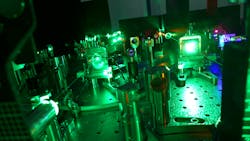Digital photonics should be called 'disruptive photonics'
PETER LEIBINGER
Technology pioneer Philippe Kahn took a photo after the birth of his daughter using a cell phone prototype he built. He then shared it with 2000 friends and his family. This was the first cell phone photo ever shot and sent (see Fig. 1). It is one of the 100 photographs that changed the world, according to Life magazine.Today, 200 million photos are uploaded every week on Facebook alone. Nearly 2 billion smartphones with an integrated camera will be sold in 2017. Digital photonics is enabling the digital world and really should be called "disruptive photonics."
Photonics is everywhere in our everyday life, but it is mostly invisible. The Internet is such an example: The amount of data on the Internet has grown 14 million times in the past 12 years. Only through harnessing light can we manage this tremendous ongoing growth. The lifelines of our modern society and economy are made of light. Millions of kilometers of optical fiber connect the world.
Light at work
Another example is manufacturing: here, the laser is the most versatile tool. It has unprecedented flexibility and unequaled precision, and the spectrum of its applications ranges from ships to chips. Only the principles of laser lithography enable the semiconductor industry to create structures the size of a virus on the chips.
The leading edge today is 14 nm—the Rhino virus that causes the common cold is twice as large. Extreme ultraviolet (EUV) lithography will enable chips with feature sizes of 5 nm in the near future. What it means for us personally is faster, cheaper, and more energy-efficient smartphones, computers, and other devices.
There would be no light without photonics—lighting as a whole accounts for around 19% of global electricity consumption. The need for energy-efficient lighting was solved by photonics with white-light light-emitting diodes (LEDs).
Light-emitting diodes' efficiency is unmatched. When we completely switch to LED lighting around the world, electricity consumption for lighting will have been reduced by more than 50%, which equals savings of almost 750 million tons of carbon dioxide (CO2) each year.
Completely novel microscopes are enabled by photonics as well, making it possible to observe a living biological cell. This capability is the fundamental for us to attack many diseases, including cancer. Photonics is also the most crucial tool in science. Lasers in different sizes enable spectroscopy or microscopy or space telescopes.
Without photonics as an enabling technology, there would be no digitalization—both go hand in hand. One example is connected light, which will enable many new applications. Street lights will be equipped with sensors and cameras, and will be connected. They will be able to monitor air quality and enable location services, and traffic control apps will derive from this feature.
Communication capabilities will allow for applications such as the availability of parking spaces and guidance of autonomous vehicles to these spaces. The installed base of street lights in 2015 was around 350 million. The infrastructure they represent is a grid we can harness! Digital light is not about illumination-it's about intelligence.
The eyes of Industry 4.0
The other game-changer that everyone is talking about is Industry 4.0. In manufacturing, this will lead to an unprecedented push for flexibility, and the laser—as a flexible and versatile tool—plays a key role here. Optical sensors and measurement devices will provide the data needed.
We can say that photonics creates the eyes and senses of Industry 4.0. However, traditional laser, sensor, and machine manufacturers will have to transform themselves to becoming a software-centric hardware manufacturer. Digital manufacturing will drive convergence of hardware and software.
Flexible Industry 4.0 tools will need to be able to interact with their environment, as well as new types of machine interfaces. Robots will become collaborative robots (cobots), which will move safely and freely in the factory through the use of vision-based sensors and through intelligent algorithms.
Novel camera systems are needed that are able to perceive their surroundings in a similar way as the human eye does. Depth of field, motion, and surface structures must be recognized-only in this way will a genuine human-machine cooperation be possible. Five hundred-thousand new cobots a year will be sold worldwide by 2025, according to Barclay Research.
3D printing/additive manufacturing is another enabler of Industry 4.0. 3D printing is the only seamless connection from digital to material known in manufacturing today. It will become an important new manufacturing method. Reduction in complexity, improved specifications, and many more factors lead to massive cost savings—and totally new possibilities and freedom when it comes to design (see Fig. 2).Autonomous cars will change mobility completely, as they are enabled by photonics. Without photonic sensors such as digital cameras and computer vision systems (both visible and infrared) taking millions of data points each second, autonomous cars could never become reality. Our industry is at the forefront of this development and we expect this to be a €9 billion market for photonics by 2020.
Extreme light: No limits
Another highlight is extreme light. Through the development of ultrafast lasers with pulse widths in the femto- and attosecond range, extreme powers are possible. Such lasers are used as production tools already, and even more powerful versions are being developed and built in the Extreme Light Infrastructure (ELI) project in Europe (see Fig. 3).Extremely energetic pulses will enable completely new technologies, such as the substitution of synchrotrons and the generation of synchrotron radiation for medical and other applications. A synchrotron costs upwards of €100 million and is a few hundred meters in diameter.
It is conceivable to build a tabletop version of a synchrotron using ultrafast lasers to generate ion or proton beams that are used for the treatment of cancer and new types of cancer diagnoses. It will even be possible to use such energy in the transformation of nuclear waste to benign isotopes with very short half-life times. The use of high-energy lasers indeed seems to be without limits.
Enabler of digitalization
Photonics is a powerful and high-tech industry, creating leading-edge technology for a worldwide €650-billion market in 2020. But photonics is more than just a successful high-tech industry—it is the enabler of digitalization in many ways. This leads to huge opportunities and risks for our industry at the same time.
The opportunities are obvious, but with the markets we serve and through the industries we enable, we will have to change ourselves. So, because we disrupt, we will be disrupted. If we do it well, photonics will be the glue and the enabler for the big topics in the digital society. The solutions will be for us to be the drivers of the change, not the victim.
Dr. Peter Leibinger gave this speech at the code_n event in September 2016. Watch the complete speech at https://youtu.be/b7u3iI_o7Jw.
Peter Leibinger is vice chairman of the managing board of the TRUMPF Group, Ditzingen, Germany; www.trumpf.de.



